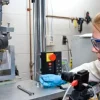The world of materials testing relies on sophisticated equipment designed to measure one of the most fundamental properties in engineering: elasticity. Engineers and materials scientists use specialized instruments to understand how materials respond to applied forces, revealing crucial data that determines whether a material will serve its intended purpose or fail catastrophically under load.
Material elasticity the ability to deform under stress and return to its original shape when that stress is removed defines the usable limits of everything from reinforced concrete structures to advanced composites in aerospace applications. The equipment that measures these properties represents the culmination of centuries of engineering evolution, combining precision mechanics with digital analytics.
Universal Testing Machines
Universal Testing Machines (UTMs) stand as the cornerstone of material elasticity testing, offering versatility that few other devices can match. These machines apply controlled forces whether tension, compression, or flexure while precisely measuring the resulting deformation. Modern UTMs combine robust mechanical frameworks with sensitive load cells and displacement sensors, creating systems capable of testing materials ranging from soft polymers to hardened steel.
The digital transformation of UTMs has revolutionized elasticity testing. Contemporary models feature computer-controlled servo motors that apply forces with microsecond precision, while data acquisition systems capture thousands of measurements per second. This level of control allows engineers to develop sophisticated testing protocols that reveal material behavior under complex loading conditions, not merely static forces.
What separates premier UTMs from basic models lies in their adaptability across testing scales. Top-tier systems can apply forces from mere newtons to several meganewtons, accommodating specimens from delicate wire to substantial structural components. This range makes them indispensable in industries where materials must perform across diverse stress environments.
Precision Deformation Measurement
While UTMs provide the force, extensometers and strain gauges deliver the critical measurements that define elasticity. These devices quantify dimensional changes occurring in materials under load—often measuring displacements smaller than a human hair’s diameter. Extensometers attach directly to test specimens, using mechanical, optical, or laser systems to track minute changes in length.
Strain gauges represent an alternative approach, consisting of thin metallic foils that change electrical resistance when stretched or compressed. When bonded directly to test specimens, they provide localized strain measurements with remarkable sensitivity. Engineers often deploy multiple gauges in rosette patterns to capture directional strain behavior, revealing material anisotropy that single-axis measurements might miss.
Advanced non-contact extensometry has transformed testing capabilities for challenging materials. Digital image correlation systems track surface patterns on specimens using high-resolution cameras, calculating strain fields across entire surfaces rather than at discrete points. This visualization capability proves invaluable when analyzing materials with non-uniform properties or complex geometries.
Dynamic Mechanical Analyzers
While static testing provides foundational elasticity data, many materials exhibit time-dependent behaviors that require specialized equipment. Dynamic Mechanical Analyzers (DMAs) subject materials to oscillating forces, measuring how elasticity changes with frequency and temperature. This capability proves essential when evaluating viscoelastic materials like polymers, composites, and biological tissues.
DMAs reveal properties invisible to static testing methods, including storage modulus (energy stored elastically), loss modulus (energy dissipated as heat), and damping characteristics. These parameters influence how materials perform under cyclic loading, vibration, and impact critical considerations in applications from automotive components to medical implants.
Temperature control chambers integrated with DMAs allow materials scientists to characterize elasticity across operational temperature ranges, identifying transition points where material properties change dramatically. This comprehensive assessment prevents unexpected failures when materials encounter environmental extremes during service.
Surface-Level Elasticity Assessment
When bulk testing proves impractical or when engineers need to evaluate specific regions of a material, indentation testing systems provide targeted elasticity data. These instruments drive hardened probes into material surfaces under controlled conditions, measuring both penetration depth and recovery. The resulting force-displacement curves yield elastic modulus values comparable to those from bulk testing methods.
Nanoindentation represents the frontier of this technology, using diamond probes with tip radii measured in nanometers to assess elasticity at microscopic scales. This capability proves invaluable for thin films, coatings, and heterogeneous materials where properties vary spatially. Advanced systems combine indentation with atomic force microscopy or scanning electron microscopy, correlating mechanical properties with structural features.
The non-destructive nature of microindentation and nanoindentation makes these techniques particularly valuable for finished components and rare materials. Engineers can map elasticity variations across surfaces without compromising structural integrity, identifying potential failure points before they manifest under operational conditions.
Investigating Elastic Constants
For materials with complex elastic behavior—particularly crystalline structures and advanced composites Resonant Ultrasound Spectroscopy (RUS) provides comprehensive elasticity characterization. This technique measures the natural resonant frequencies of precisely machined specimens, then uses mathematical models to extract the complete set of elastic constants that govern material behavior.
Unlike conventional testing methods that evaluate single properties, RUS simultaneously determines multiple elastic parameters, including those governing anisotropic behavior. This holistic approach proves particularly valuable for materials used in aerospace, defense, and energy applications, where directional properties significantly impact performance and reliability.
The non-destructive nature of RUS allows for monitoring changes in elasticity over time, making it ideal for studying aging effects, radiation damage, and environmental degradation. This longitudinal assessment capability helps engineers predict remaining service life for critical components, preventing unexpected failures in high-consequence applications.
Elasticity Testing for Concrete and Building Materials
The construction industry relies heavily on material elasticity testing, particularly for structural components like reinforced concrete. According to the American Concrete Institute’s comprehensive guide on testing methods, concrete elasticity directly influences structural performance under both static and seismic loading conditions. Specialized equipment measures elastic modulus values that inform design decisions and quality control processes.
Concrete elasticity testing requires robust compression frames capable of applying forces exceeding several meganewtons. These systems accommodate standard test specimens, including the iconic concrete cubes that serve as industry benchmarks. Advanced testing protocols measure not only ultimate strength but also elastic deformation characteristics that predict how structures will respond to loading events throughout their service lives.
The relationship between concrete microstructure and elasticity represents an active research area, with specialized equipment now characterizing how aggregate composition, cement chemistry, and curing conditions influence mechanical properties. This detailed understanding allows engineers to design concrete formulations tailored for specific applications, from dams requiring minimal thermal expansion to high-rise buildings demanding exceptional seismic performance.
Optical Measurement Systems: Visualizing Elasticity
Contemporary elasticity testing increasingly incorporates optical measurement systems that visualize material deformation across entire surfaces rather than at discrete points. Digital image correlation, laser speckle interferometry, and holographic techniques track minute displacements occurring during loading, generating full-field strain maps that reveal behavior invisible to conventional sensors.
These visualization capabilities prove particularly valuable for composite materials, welds, and structures with complex geometries. Engineers can identify strain concentrations that might initiate failures, optimize designs to distribute loads more effectively, and validate finite element models against real-world behavior. The resulting insights often lead to components that maximize strength while minimizing material usage a critical consideration for sustainability.
Advanced optical systems operate across multiple scales, from macro-level measurements of entire structures to microscale observations of deformation mechanisms. This multi-scale approach bridges the gap between material science and structural engineering, connecting fundamental material properties to real-world performance outcomes.
Wrapping Up
The equipment used to test material elasticity represents far more than scientific instrumentation—it forms the foundation upon which modern engineering confidence rests. From massive concrete structures supporting urban infrastructure to microscopic medical implants sustaining human lives, materials must perform precisely as predicted. Testing equipment provides the empirical evidence that transforms theoretical models into actionable engineering decisions.
As materials technology continues advancing toward greater complexity and specialization, elasticity testing equipment evolves in parallel, offering unprecedented measurement precision and analytical capabilities. This coevolution ensures that even as we develop materials with increasingly sophisticated property profiles, we maintain the ability to characterize them comprehensively, minimizing the uncertainty that leads to overdesigned components or unexpected failures.
The future of elasticity testing lies not merely in greater precision but in deeper integration with computational methods, artificial intelligence, and automated testing workflows. These advancements will accelerate materials development cycles while maintaining the rigorous validation processes that ensure public safety and engineering reliability. The equipment that measures how materials respond to forces today shapes the materials that will define our built environment tomorrow.Retry







